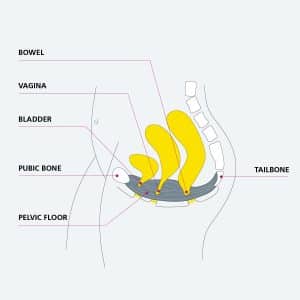
The pelvic floor is a bowl of muscles that attaches to the pubic bone at the front and the coccyx or tailbone at the back.
The entrance to the bladder, vagina and bowel all pass through the pelvic floor. It acts like a hammock to provide support to these passages and to the bladder, bowel and uterus above.
What effect will pregnancy and birth have?
We know that pregnancy and childbirth have an impact on your pelvic floor. The weight of your baby during pregnancy will put more load on the area and can stretch and weaken the muscles. A vaginal birth will cause further stretching and 50-75% of the time will involve a tear into the muscles. Other factors can further impact the pelvic floor including the use of forceps to deliver baby or if you give birth to a larger baby.
What does my pelvic floor do?
A pelvic floor that works well is important for several reasons:
- To maintain bladder and bowel continence
Fact: 1 in 3 women experience urinary incontinence. Doing pelvic floor exercises antenatally and postnatally can help to prevent this.
- To support the pelvic organs and prevent prolapse
Fact: Pelvic organ prolapse is the bulging down of 1 or more of: the front vaginal wall, the back vaginal wall, the cervix or uterus. It can cause symptoms of a bulge in the vagina as well as bladder, bowel and sexual symptoms. 50% of women are noted to have a degree of prolapse when they are examined.
- To maintain or improve sensation during sex and your ability to orgasm
Fact: The pelvic floor has a significant influence on sexual function and pleasure.
- A pelvic floor that is working well, may help in the pushing stage of labour
How to do your pelvic floor exercises
Sit comfortably on a chair with your knees apart, or if it is more comfortable, you can do them lying down. To contract your pelvic floor – tighten your back passage, as if you are trying to stop yourself from breaking wind. Don’t squeeze your buttocks or leg muscles, it is an internal contraction. Do not hold your breath, continue to breathe normally while doing these exercises.
There are some other prompts that might be useful – find the one that works best for you:
- Tighten your vagina as if you are trying to stop the flow of urine
- Try to feel the muscles tighten upwards and forwards towards the pubic bone.
- Feel the muscles working together, then relax.
How often should I do pelvic floor exercises?
Aim to do your pelvic floor exercises 3 times each day during pregnancy and after you give birth and continue them longterm. You should be aiming to do 10 quick and 10 slow contractions (10 seconds holds) once per day, for the rest of your life.
To begin with, if you haven’t practised the exercises before, it can feel difficult. Don’t panic, just practice gently contracting and relaxing up to 10 repetitions, 3-4 times per day.
Once you feel you have mastered this and you can do the exercises comfortably – have a go at holding this contraction.
How many seconds should I hold the contraction for?
Aim for 5 seconds to begin, when you let go – can you feel the muscles relax?
If not, you have held the contraction for too long, try again with a shorter hold – even just one second. Some women may only be able to only hold for 1-2 seconds. Others as many as 8-10 seconds.
Don’t panic if you are not able to feel very much. It may take 6-8 weeks for the swelling to go down, and for you to feel confident in doing these exercises. Keep practising these exercises. It is important to discover your hold time, and gradually build this up, to a maximum of 10 seconds.
Your pelvic floor exercise programme should incorporate slow and quick contractions
Exercise 1 – Slow pull ups
It’s important not to hold your breath, so as you breathe out, tighten your pelvic floor muscles slowly. Continue to tighten them for YOUR length of hold. You can count out loud to ensure that you’re still breathing. Relax and feel the muscle let go. Rest for approximately 5 seconds. Repeat this 5 times. As it gets easier, gradually increase the length of hold and the number of repetitions, aiming for 10 second holds.
Exercise 2 – fast pull ups
Tighten the pelvic floor muscles quickly. Let go straight away and wait for 5 seconds. Repeat this 10 times.
Pelvic floor exercise routine
Do exercises 1 and 2 at each session. As soon as you can, increase to 10 slow and 10 fast pull ups. Aim to repeat each session 3 to 4 times per day.
Another good habit to get into is to try and tighten your pelvic floor muscles before you cough, sneeze or lift anything. This is known as ‘the knack’.
As your muscles get stronger, you may progress to doing the exercises in standing as well as in sitting or lying. Don’t expect immediate improvement – so do not give up!
During pregnancy with the increasing weight of your baby, the exercises may feel more challenging and you may need to go back to doing them in sitting or lying. You should still continue this routine for the duration of your pregnancy.
Don’t practice stopping the flow of urine mid-stream, as this might interfere with the normal processes of emptying your bladder.
Remember, you should be aiming to do 10 quick and 10 slow contractions (10-second holds) once per day, for the rest of your life. The reason for this is because these exercises may prevent issues later in life with the pelvic floor.
To optimise the long-term health of your pelvic floor, it is important to maintain a healthy weight, avoid constipation and straining on the toilet, as well as doing your pelvic floor exercises.